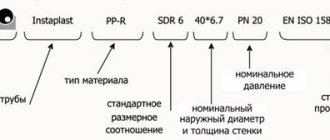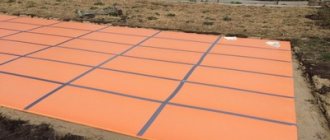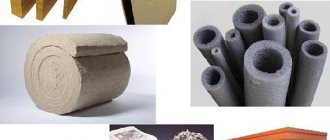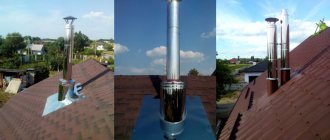Arranging a country house in the absence of common communal water supply and sewerage systems is a difficult task for any homeowner. In addition to providing residents with drinking water, it is necessary to solve the problems of draining gray water and sewage, while not forgetting about the insulation of external sewer pipes.
This problem can be solved in various ways; to select the appropriate option, it is useful to know how external sewerage pipes in the ground are insulated and to study this technology. This will allow for proper and long-term insulation of the sewer system with minimal time and financial losses.
Rice. 1 Sewerage of a private house - device
Is it necessary to insulate the sewer system and problems when pipes freeze?
When draining sewer and gray water from a private house at sub-zero ambient temperatures, they can freeze, and this will cause the following unpleasant consequences:
- Frozen water will prevent drainage from the house, thereby creating significant difficulties for living in the private sector in the winter.
- Also, when defrosting, water expands, which causes damage to pipelines and clogging of the ground with sewage, worsening the environmental situation.
- Ice plugs that prevent the outflow of contaminated water will cause it to stagnate in the drainage system - as a result, unpleasant odors will appear in the home, interfering with comfortable living.
Rice. 2 Map of soil freezing level - example
Insulation of external sewer pipes - generally accepted methods
When deciding how to insulate a sewer system in a private house, a number of methods are considered, the main ones being:
- Depression in the ground. To implement this method, a prerequisite is to place the pipe outdoors in a trench below the maximum freezing point for the given area.
- Using an electrical cable. This technology for insulating external sewers is easily implemented thanks to the manufacturer, which produces reliable moisture-resistant electric heating cables placed inside the pipeline or special sockets in the pipes.
- The use of insulation. This method of thermal insulation can be quite simply implemented thanks to the shells produced from various types of insulation with a diameter suitable for sewer insulation.
- Combined methods. An excellent solution for thermal insulation of sewer pipelines is the use of additional insulation by placing them in a shell of insulation at an average depth in the ground. Another common option is to place the heating electric cable in a sheath of insulation, while the sewer line is located at a short distance from the surface of the earth.
Rice. 3 Installation of pipes in a trench
Selection of materials
First of all, we need to decide what kind of insulation for sewer pipes we will use. His choice will be influenced by the quality and cost of the material. The following types of insulation are available on the market:
- expanded polystyrene. Thanks to the special dense granules of this product, reliable thermal insulation of the channel is ensured, in addition, the water supply is reliably protected from the penetration of water from the ground. A special lock allows for quick installation of pipes in the ground, without significant time costs for insulation;
- basalt fiber. Reliable and comfortable insulation. Allows you to do the work yourself, as it does not require special installation techniques. There is a waterproofing layer on the surface that prevents the material from swelling. For closure there is adhesive tape on the side of the channel. However, the cost of basalt fiber is high, and it is not suitable for laying long lengths of pipes;
- polystyrene foam has properties similar to expanded polystyrene. At a relatively low price, it is easy to install; there is no need to install special trays for pipes; the “shells” have locks. The joints are reinforced with special tape;
- penoizol is a liquid insulation material that, after hardening, turns into a dense, hermetic shell for the pipe. There is no need to lay it, just treat the channel after installation. When insulating pipes in the ground with foam insulation, it is necessary to compact the walls of the trench;
- polyurethane foam is available in the form of shells with a lock;
- Foamed polyethylene must be closed using construction tape. Overall the material is light and cheap. Suitable for insulating pipes in the ground;
- Rolled glass wool is often used to insulate external sewers. It has excellent thermal insulation, but cotton wool is easily saturated with water and loses its beneficial properties. Therefore, it is necessary to additionally attach a layer of waterproofing, which increases the cost of insulation and slows down the installation process.
Insulation using soil when laying a pipeline below the freezing depth
Insulating sewer pipes in the ground using this method is the most affordable process, because in areas with a temperate climate, the depth of soil freezing is about 1.5 meters. When determining the depth, you can be guided by special ground freezing maps for different regions; laying a pipeline below the freezing depth has the following features:
- When installing a pipeline in the middle zone or northern latitudes, a large amount of excavation work will be required - this will lead to high financial costs.
- The volume of land sampling and costs will increase even more if the distance of the sewer line from the house is too large, because along the entire route it is 110 mm. the pipeline must provide a minimum technical slope of 20 mm. per linear meter. Compliance with this condition leads to the fact that at a 50-meter distance the height difference can reach one meter - therefore, the lowest point will be at a depth of 2.5 meters.
- The deep location of the pipeline underground makes it difficult to carry out repair work in case of damage.
Fig. 4 Thermal insulation of sewerage with a heating cable - type of wire
Related article:
Sewerage in the country - options, design diagrams and installation. If you need to install a sewer system in your dacha, then in a separate article read about all the possible expensive and cheap options for arranging a sewer system in your dacha. Nuances, types, schemes.
How to choose insulation
When using insulation, you should try to select a material that is optimally suited for its properties, taking into account the characteristics of the soil in which it will be laid.
In general, types of insulation can be divided into several groups:
- Bulk;
- Roll;
- Slab sheet;
- Foam blocks.
When using the first type, the pipeline laid in a trench can simply be covered with expanded clay. This method of insulating sewer pipes in the ground with your own hands is the simplest and most inexpensive, but is only suitable if the trench is dry. For roll and slab types of insulation, a protective waterproofing box will be required. This is necessary to prevent the formation of ice jams in cold winters.
High-quality insulation of external sewer pipes is due to well-chosen material. The range of thermal insulation materials for sewer pipes on the market is very wide and it is not so easy to make a choice. But what you definitely need to pay attention to is that the insulation is already waterproofed. In this case, you won’t have to worry about additional measures.
Heating of external sewerage using cable
When deciding how to insulate sewer pipes in a private home, many choose a heating cable. During installation, it is placed along or wrapped around the pipeline, if strong heating is required; a common option is to place the heating wire inside the pipeline. The use of electric heating has the following features:
- Electric cable is quite expensive, the price of one linear meter is approximately 15 USD.
- With electrical heating, it is possible to place the sewer line in the ground not too deep; its usual depth is no more than 0.5 meters and can be reduced by using a powerful electric cable with a small winding pitch.
- The heating wire can be placed in pipe channels specially made for its installation or attached to a plastic pipeline with your own hands using foil adhesive tape.
Sewer insulation
Thermal insulation of sewer pipes is carried out using the following methods:
- Depths of the sewer system below the soil freezing level. At this depth, the soil temperature becomes the same throughout the year. 10-12°C, which are observed at depth, do not allow the nets to freeze. But this option also has its disadvantages. Firstly, trenches are dug to a depth of 1.5-3 meters, which is a labor-intensive process. Secondly, if the network is damaged (blockage, breakthrough, etc.), the trench will have to be torn up again. Most often, this method is practiced during the construction of sewers in apartment buildings, as well as when installing a water supply system in the ground;
- Insulation of sewer pipes with materials with low heat transfer. It is more often used in cases where sewer pipes are laid above or on the surface of the ground, or laid in the ground to a shallow depth. The pipeline should be laid with a slight slope towards the storage tank (about 1.5-2.0 cm per 1 linear meter of pipe). This will avoid stagnation and the formation of wastewater plugs;
- Heating with electric cable. The electrical cable is installed along the pipes outside or inside. It is recommended to mount it from the outside, which prevents damage to the shell.
Important! The insulation does not heat the external sewer pipes, but only slows down their cooling. Without constant drainage or heating, the system will still cool to a temperature below 0. As a result, wastewater discharged in small portions will form ice build-ups. Therefore, if the sewer system is used infrequently, it is recommended to locate the networks below the ground freezing level, or to additionally provide for the installation of a heating cable.
How to insulate sewer pipes in a private house? Which protection option should you choose? Thermal insulation using insulation has become widespread among owners of private houses. The pipes are located at a depth of 0.5-1.0 meters and are lined with heat-saving material. Often combined methods are used, which provides more reliable protection.
Insulation using thermal insulation materials
When determining how to insulate a sewer pipe on the street, insulation is often chosen using insulation materials widely used in the construction industry. Typically, for ease of installation, they have a cylindrical shell with an internal diameter corresponding to the standard size of a sewer pipe.
Glass wool
The main element of this heat insulator is long glass filaments, which are obtained from broken glass by heating to 40º C and blowing from a centrifuge - this significantly reduces the cost of the manufacturing process.
Rice. 6 Insulation for sewer pipes made of glass wool
Fibers with a thickness of 3 - 15 microns. are suspended in the air, so the material has a low density and high resistance to vibration; in addition, glass wool has the following useful properties:
- The material is non-flammable, has high heat resistance and can withstand temperature ranges from -400 to +700 C.
- Its thermal conductivity ranges from 0.045 to 0.065 W/m*C., which is a rather low indicator, second only to some polymer materials.
- Glass wool allows steam to pass through and is not afraid of moisture; it is resistant to a large number of aggressive chemicals and biological effects.
- The material is environmentally friendly and harmless to human health.
The disadvantages of glass wool as insulation include its low density, tendency to shrink and inconvenience of installation.
Glass wool is produced in rolls and slabs; foil cylindrical shells with the appropriate internal diameter are most suitable for sewer insulation.
When installed under a layer of earth, glass wool will be subjected to compression and can absorb moisture - this significantly reduces its thermal insulation properties and limits its use as a heat insulator for the sewer line.
Fig.7 Thermal insulation of sewer pipes in the ground with mineral wool
Mineral wool
Mineral wool is produced in two types - slag wool and basalt. The first has low density and high water absorption, it is not recommended for use on metal surfaces and in residential areas - due to these properties it has very limited use.
Basalt mineral wool, which is produced by melting basalt and forming thin fiber from it, rightfully occupies a leading position among insulation materials, having the following useful properties:
- Low thermal conductivity 0.04 W/m*C. promotes the widespread use of the material in the construction industry for insulation of various types of surfaces and pipelines.
- The material is non-flammable, resistant to many chemicals and temperature changes, and is environmentally friendly.
- Cotton wool is resistant to moisture, but can absorb it, so it is recommended for use in a dry environment.
- Unlike glass wool, basalt wool has a higher density, making it easier to install and more efficient to use under surface pressure conditions.
For insulation of pipelines, basalt wool is produced in the form of segmented cylindrical rolls, often with a foil coating.
Although basalt wool has a high density and can go deep enough into the ground without changing its thickness or losing its properties, its ability to absorb moisture limits the use of the material as insulation.
Rice. 8 Izolon - appearance and application
Types of thermal insulation for sewer pipes
Insulation of pipes with glass wool
Most often, the following materials act as passive insulation:
- mineral wool;
- glass wool;
- slag;
- expanded clay;
- expanded polystyrene or foam;
- polyurethane foam;
- foamed polyethylene.
Mineral or stone wool is a fibrous material that is obtained by heating rocks to a melting point of 1500 degrees. The resulting mass, reminiscent of lava, is fed to centrifuges, where stone threads are pulled out using air flows and filters.
Fiberglass is made from quartz, sand or recycled materials. Broken glass is melted and passed through microscopic holes. The resulting glass threads are wound onto spools and then treated with a lubricant, resulting in the material becoming waterproof and abrasion-resistant. Glass wool has good thermal insulation properties, flexibility and strength. As fiber thickness increases, heat loss decreases.
Slag is obtained from liquid blast furnace slag, which is blown using steam or air streams. All of the listed fiber insulation materials have different thread thicknesses, thermal insulation properties and moisture resistance. The material is a non-flammable compound; at a temperature of 250-300 degrees it loses its thermal insulation properties, and the formaldehyde it contains reduces its scope of application.
Foam insulation
Foam insulation consists of polystyrene granules (2%) and air (98%). The particle size is 1-5 mm. Using a gas generator, the elements are glued together, then a shell is formed under pressure, which can be used many times. Thermal conductivity properties are almost the same as those of mineral wool.
Polyurethane foam has a density and strength higher than that of polystyrene with the same thermal conductivity. The material is better preserved during operation and can withstand temperatures from -180 to +130 degrees.
Foamed polyethylene or energyflex has a low thermal conductivity of 0.05 and takes up little space, therefore it is used in small gaps between the pipeline and the wall. The insulation works in the range from -50 to +90 degrees. They are produced in the form of cylinders and rolls, as well as single- or double-sided foil products. Most often used in basements and unheated structures for internal sewerage and floor insulation.
Expanded clay is a bulk material that retains its thermal insulation properties only in a dry state.
Penoplex or extruded polystyrene foam is produced in the form of segments of different thicknesses and has a low cost.
How to insulate a sewer system in a private house
If there is a need to insulate a plastic sewer pipe in a house, you can use all of the above materials. From an economic point of view, ease of installation and aesthetics, the largest number of homeowners prefer isolon. It is simply fixed on the insulated surface through a side cut, and can be glued or connected with adhesive tape. An additional advantage of the material is its highest noise absorption among all heat insulators.
Fig. 11 Insulation of external sewer pipes in a private house with isolon
When deciding how to insulate underground sewers, they take into account climatic conditions, ease of work, and cost of materials. The optimal choice of insulation for underground sewerage, with a wide variety, is not too large - it can be an electrical cable or a shell made of hard, moisture-impervious materials - polystyrene foam or polystyrene foam. Often a combination of a heating cable and an insulating shell is used for thermal insulation.











